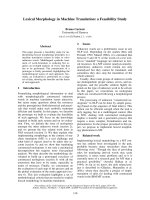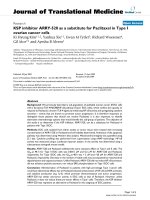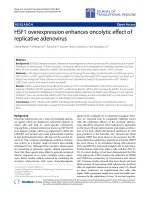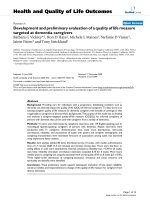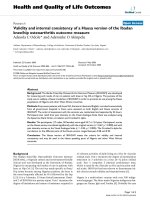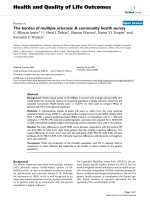báo cáo hóa học: " Neurological symptoms among dental assistants: a cross-sectional study" potx
Bạn đang xem bản rút gọn của tài liệu. Xem và tải ngay bản đầy đủ của tài liệu tại đây (243.37 KB, 7 trang )
BioMed Central
Page 1 of 7
(page number not for citation purposes)
Journal of Occupational Medicine
and Toxicology
Open Access
Research
Neurological symptoms among dental assistants: a cross-sectional
study
BE Moen*
1
, BE Hollund
2
and T Riise
1
Address:
1
Institute of Public Health and Primary Health Care, University of Bergen, Kalfarveien 31, N-5018 Bergen, Norway and
2
Department of
occupational medicine, Haukeland University Hospital, N-5009 Bergen, Norway
Email: BE Moen* - ; BE Hollund - ; T Riise -
* Corresponding author
Abstract
Background: Dental assistants help the dentist in preparing material for filling teeth. Amalgam was
the filling material mostly commonly used in Norway before 1980, and declined to about 5% of all
fillings in 2005. Amalgam is usually an alloy of silver, copper, tin and mercury. Copper amalgam,
giving particularly high exposure to mercury was used in Norway until 1994. Metallic mercury is
neurotoxic. Few studies of the health of dental assistants exist, despite their exposure to mercury.
There are questions about the existence of possible chronic neurological symptoms today within
this working group, due to this exposure. The aim of this study was to compare the occurrence of
neurological symptoms among dental assistants likely to be exposed to mercury from work with
dental filling material, compared to similar health personnel with no such exposure.
Methods: All dental assistants still at work and born before 1970 registered in the archives of a
trade union in Hordaland county of Norway were invited to participate (response rate 68%, n =
41), as well as a similar number of randomly selected assistant nurses (response rate 87%, n = 64)
in the same age group. The participants completed a self-administered, mailed questionnaire, with
questions about demographic variables, life-style factors, musculoskeletal, neurological and
psychosomatic symptoms (Euroquest).
Results: The dental assistants reported significant higher occurrence of neurological symptoms;
psychosomatic symptoms, problems with memory, concentration, fatigue and sleep disturbance,
but not for mood. This was found by analyses of variance, adjusting for age, education, alcohol
consumption, smoking and personality traits. For each specific neurological symptom, adjusted
logistic regression analyses were performed, showing that these symptoms were mainly from arms,
hands, legs and balance organs.
Conclusion: There is a possibility that the higher occurrence of neurological symptoms among
the dental assistants may be related to their previous work exposure to mercury amalgam fillings.
This should be studied further to assess the clinical importance of the reported symptoms.
Published: 18 May 2008
Journal of Occupational Medicine and Toxicology 2008, 3:10 doi:10.1186/1745-6673-3-10
Received: 7 October 2007
Accepted: 18 May 2008
This article is available from: />© 2008 Moen et al; licensee BioMed Central Ltd.
This is an Open Access article distributed under the terms of the Creative Commons Attribution License ( />),
which permits unrestricted use, distribution, and reproduction in any medium, provided the original work is properly cited.
Journal of Occupational Medicine and Toxicology 2008, 3:10 />Page 2 of 7
(page number not for citation purposes)
Background
Mercury is known to be a potential health hazard, both for
kidneys, the nervous system and reproduction [1-3]. Per-
sons employed in the dental profession might have been
exposed to metallic mercury during their work with the
dental filling material amalgam. Amalgam has been the
main dental filling material in Norway from 1945 to the
mid-1980s. One of the amalgam filling materials used
was the alloy copper amalgam [4]. It was prepared by
heating a tablet, and this could give concentrations of
mercury fumes in the air above 1.0 mg/m
3
, 20 times the
limit value in Norway at the time [5]. Other types of amal-
gam alloys and different preparation methods have also
been applied, causing less mercury exposure. In 1981 the
Norwegian Health Authorities recommended the dentists
to avoid the use of copper amalgam, due to possible
adverse health effects. This request was repeated in 1994,
as the compound was still in use. After this last request,
the use of copper amalgam declined to almost zero.
Preparing dental fillings is one of the main work tasks for
dental assistants, although dentists some times perform
this work as well. Several studies have confirmed the mer-
cury exposure in dental offices [6-9]. Mercury vapour lev-
els in dental clinics have been shown to exceed the limit
values in Canada in 1983 [10]. Little effort has been made
to differentiate between the mercury exposure of dentists
and dental assistants, but it seems like the dental assist-
ants may have higher exposure levels [11].
As dental assistants may have been exposed to high levels
of mercury during their work with amalgam, and espe-
cially during work with copper amalgam, this might have
caused chronic adverse effects in their nervous system.
However, few studies have examined such effects among
dental assistants exposed to mercury, and the studies are
small and show inconsistent results [11,12]. Recent stud-
ies indicate a relation between urine mercury levels and
neurological symptoms and adverse results on neuropsy-
chological tests of motor function among dental assistants
and dentists [13,14]. However, these studies analyse data
mostly related to current exposure conditions, but also
suggest that previous exposure might be of importance for
present symptoms[14]. This supports the hypothesis that
past exposure among these types of personnel might cause
chronic neurological symptoms.
There are several challenges related to examination of
symptoms from the nervous system. Several such self-
administered questionnaires have been elaborated
[15,16], but they all have weaknesses. The EUROQUEST
questionnaire was designed in 1992 by the European
Neurotoxic Solvents Toxicity network (EURONEST), for
use in epidemiological studies on neurotoxicity [17]. The
questionnaire has been evaluated and found to have a
high internal consistency on assessed domains [18]. It has
a specific advantage by including questions on personal-
ity, making adjustment for personality possible. Due to
these different advantages of this questionnaire, it was
chosen for the present study.
The hypothesis of the present study was that the occur-
rence of neurotoxic symptoms, especially neurological
symptoms is higher among dental assistants likely to be
exposed to past high levels of mercury during work with
dental filling material, compared to health personnel with
no occupational mercury exposure. The information
might be useful in medical examinations of dental assist-
ants.
Methods
Study design and subjects
A cross-sectional study among dental assistants was per-
formed in Hordaland County, Norway in 2005. One out
of two trade unions for dental assistants in Norway had a
good member archive. This union provided a list of all
dental assistants who were members of the union and still
at work (67 years or younger). All dental assistants from
this list, born before 1970, were invited to participate (n =
60). The age restriction made likely for a least some of the
participants to have worked with copper amalgam, as this
filling material was reduced in Norway after 1994. The
union also provided a similar list of assistant nurses, an
occupational group with no known mercury exposure at
work, and 75 of these were randomly selected for the
study. Two had moved outside the country, thus 73 were
invited to participate. The assistant nurses were chosen as
a reference group as they normally have about the same
educational level as the dental assistants. They work at
hospitals or similar institutions and care for patients
under medical treatment, and are not in dental offices.
Questionnaire
The participants were mailed a questionnaire and a letter
telling that this was a pilot study of work and health
among health personnel. Dental filling material was not
mentioned in the information. The participants were
asked to fill in the questionnaire and to return it to the
University in a prestamped envelope within two weeks.
The questionnaire enquired about age, current working
position, number of years working as a dental assistant or
assistant nurse, previous diseases, alcohol consumption
(units per month), present smoking (yes/no) and number
of cigarettes smoked. In addition, the standardized ques-
tionnaire EUROQUEST was included [17,19,20]. The
questionnaire was translated from English to Norwegian
and back again, using standard procedures for transla-
tions. The EUROQUEST questionnaire measures neuro-
logical symptoms (11 items), psychosomatic symptoms
Journal of Occupational Medicine and Toxicology 2008, 3:10 />Page 3 of 7
(page number not for citation purposes)
(15 items), mood (11 items), memory (6 items), concen-
tration (4 items), fatigue (7 items), sleep disturbances (5
items). In addition the EUROQUEST includes questions
on anxiety (6 items) and perception of health status and
life (4 items), usually used for adjusting for personality
traits [20]. Each item was scored from 1 to 4 according to
its frequency. The domains acute symptoms and environ-
mental susceptibility from the original EUROQUEST were
not included, as these questions focused on exposures,
which we wanted to avoid in the present study to reduce
information bias. Scores were calculated for neurological
symptoms, psychosomatic symptoms, mood, memory,
concentration, fatigue, sleep disturbances and anxiety/
general health by summarizing the scores from each
group of questions. In addition, the questionnaire
included items concerning musculoskeletal symptoms,
using a modification of the Standardized Nordic Ques-
tionnaire [21,22] The questions were phrased: "Have you
at any time the last 12 months, had ache, pain or discom-
fort in (body area)?" The body areas were head, neck,
shoulders, elbows, hands, upper back, lower back, hips,
knees and ankle/feet. The answers were given on a five-
point scale. These questions were added after a suggestion
from the trade union involved, as they were particularly
interested in the topic. As the occurrence of musculoskel-
etal symptoms might be high among health personnel
[23,24], it was likely that the workers would be motivated
to answer the questionnaire when this subject was
included, although the topic was not any main aim of the
study.
Statistical Analysis
Differences among the dental assistants and the assistant
nurses in age, years at work in question, alcohol units and
number of cigarettes smoked daily were analyzed by t-
tests. Differences in education and smoking status were
tested using chi-square tests. Differences in mean scores of
the EUROQUEST scales between the dental assistants and
the reference group were examined by analyses of vari-
ance, adjusting for age, education, alcohol consumption
(units per week), smoking (cigarettes per week), years at
work as well as for personality traits (anxiety and general
health). The adjusted mean differences were also
expressed as effect size by dividing the difference by the
standard deviation in the total study population. Each
neurological symptom was also categorized (0/1) into sel-
dom/never and sometimes/often/very often, and the
occurrence of each symptom was compared between the
groups by logistic regression analyses, adjusting for age
(below or above 55 years), education (primary school/
collage or university), alcohol consumption (below or
above 4 units per month), current smoking (yes/no) and
personality traits (score categories below or above mean
for both groups). The chosen cut points for age and alco-
hol consumption were the mean levels for the whole pop-
ulation. Logistic regression analyses with similar
adjustments were also performed for the different muscu-
loskeletal symptoms. Due to a correlation between age
and years at work (Pearson's correlation coefficient = 0.53,
p < 0.000), only age was included in the main analyses.
However, additional analyses were also performed includ-
ing the years at work. Adjusted odds ratios and 95% con-
fidence intervals were calculated.
Ethics
The Regional Committee for Medical Research Ethics in
Health Region West of Norway, and The Norwegian Social
Science Data Services (NSD) approved the project.
Results
The response rate was 68% for dental assistants and 87%
for the assistant nurses. The groups had similar educa-
tional levels (Table 1). The dental assistants were older,
had more years at work, and higher alcohol consumption
than the assistant nurses. More assistant nurses were
smoking. The dental assistants had started their career in
this occupation between 1956 and 1994, and fifty percent
of them had been working more than 30 years in this
work (Table 1). All except two had started this work before
1980. The groups did not differ regarding previous dis-
eases, except for one dental assistant who had had a brain
tumour. This person was excluded from the further analy-
ses.
Regarding musculoskeletal symptoms, no differences
were found between the groups in a logistic regression
analysis, adjusting for age, education, alcohol consump-
tion and current smoking. This was also the case when the
variable years at work was included in the model. The
dental assistants reported markedly and significantly
higher occurrence of neurological symptoms, psychoso-
matic symptoms, memory, concentration, fatigue and
sleep disturbance than the reference group. This was
found when adjusting for age, education level and lifestyle
factors, as well as personality traits (Table 2). The largest
difference (effect size) was found for memory deficit. The
groups did not differ significantly concerning mood, anx-
iety and perception of health status and life. The last two
factors were still included in the analyses of variance as
covariates to adjust for personality traits. Including years
at work in the analysis in addition to age did not change
the results.
All single neurological symptoms recorded, except "felt
slow in carrying out your daily activities", occurred more
in the group of dental assistants (Table 3). Further, seven
out of eleven symptoms were significantly more frequent.
Including years at work in the analysis in addition to age
did not change the results.
Journal of Occupational Medicine and Toxicology 2008, 3:10 />Page 4 of 7
(page number not for citation purposes)
Discussion
The dental assistants reported markedly and significantly
more neurological symptoms, psychosomatic symptoms,
memory loss, concentration difficulties, fatigue and sleep
disturbance than a reference group of assistant nurses. The
memory loss seemed to be most important.
The possible exposure to mercury among the dental assist-
ants during their work with filling material might be an
explanatory factor for this finding, as this exposure was
not likely among the referents. However, we had no spe-
cific information about the individual exposure to mer-
cury during the work among these women, as the
questionnaire contained no such questions to reduce
recall bias. The dental assistants in the present study had
been working at a time when copper amalgam was being
used in Norway, and they were very likely to have been
exposed to mercury in their dental work. This is supported
by a study of mercury in urine samples among dental
assistants and dentists in Hordaland performed in 1985.
The study demonstrates similar exposure levels for mer-
cury in this group compared to Norwegian dental person-
nel elsewhere in the country [25].
Other neurotoxins may be in use in dental offices, but as
there is no documentation of this exposure, these assump-
tions are speculative. For instance, in several countries, the
neurotoxin nitrous oxide has been used extensively in
dental offices as an anaesthetic agent. However, this gas
Table 1: Characteristics of the study population
Dental assistants (n = 41) Assistant nurses (n = 64) p-value
Mean (SD) range Mean (SD) range
Age 57.8 (6.7) 37–67 52.5 (8.3) 36–67 0.001*
Years at this particular work 29.7 (8.2) 11–42 17.5 (11.8) 1–40 0.001*
Alcohol units in a month 4.8 (3.8) 0–15 2.6 (3.0) 0–12 0.010*
Cigarettes smoked daily 3.7 (5.6) 0–20 7.2 (6.3) 0–20 0.004*
No (percent) No (percent)
Educational level
- Only primary school 32 (79) 45 (70) 0.079**
- Primary school and college 9 (21) 16 (25)
- University 03 (5)
Present smokers 7 (17) 32 (50) 0.001**
Years at this particular work
-<10 0 20 (34)
11–20 8 (18) 17 (26)
21–30 13 (32) 18 (27)
>30 20 (50) 7(13)
* Student's t-test** Chi-square test
Table 2: Differences between dental assistants (n = 40) and assistant nurses (n = 64) in scores on domains of the questionnaire
EUROQUEST, tested by univariate analyses of variance
Domain Unadjusted data Adjusted data
Dental assistants Assistant nurses p-value Effect size* R
2
Mean/SD Mean/SD
Neurological symptoms 18.1/5.0 14.6/4.0 0.028 0.49 0.367
Psychosomatic symptoms 21.6/5.9 18.8/4.0 0.024 0.50 0.347
Mood 18.8/5.9 16.7/4.8 0.257 0.24 0.410
Memory deficit 11.4/4.1 9.1/2.6 0.003 0.59 0.401
Concentration difficulties 6.7/1.9 5.6/1.6 0.045 0.50 0.182
Fatigue 14.7/5.7 11.8/4.3 0.023 0.49 0.389
Sleep disturbance 10.1/3.3 7.9/2.4 0.010 0.52 0.338
1
Adjusted for age, education, alcohol consumption (units per week), smoking (cigarettes per week) and personality traits (anxiety and general
health).
2
Effect size= The difference between the mean values of the two occupational groups, divided by the standard deviation.
SD= standard deviation. R
2
= Adjusted R squared
Journal of Occupational Medicine and Toxicology 2008, 3:10 />Page 5 of 7
(page number not for citation purposes)
has in general been used relatively little in Norwegian
dental offices.
The central nervous system has been described to be vul-
nerable for chronic exposure to low levels of inorganic
mercury over several years [26]. Tremor, nervousness and
memory disturbances have also been reported [27-29].
Previous studies of dental personnel are few. One study of
neuropsychological functioning [12] has shown reduced
short-term memory among dental auxiliaries. Two Scot-
tish studies have shown high prevalence of memory dis-
turbance among dentists [30,31], and similar findings
among dental personnel have been shown in Sweden
[11].
Psychomotor tests of dental personnel have shown a rela-
tion between mercury exposure and lower scores on the
Intentional Hand Steadiness Test and finger tapping,
although the general mercury levels were quite low
[13,32]. The neurological symptoms we found clearly
show that the dental assistants have problems with the
hands and arms, and this is consistent with the studies
mentioned. However, dentistry requires controlled hand
movements and precision. Symptoms from arms and
hands may be noticed earlier among dental workers than
in other occupational groups, as mentioned in a Swedish
study of musculoskeletal symptoms among dental per-
sonnel [33]. However, this Swedish study also included
dentists, who handle vibrating hand tools, and this might
have given symptoms from arms and hands as well, and
the population is not quite comparable. Nevertheless,
early notification of symptoms can probably not alone
explain the reported neurological symptoms in the
present study, as symptoms independent of the hands
were reported as well. Also, there was no difference
between the groups regarding questions about muscu-
loskeletal pain in the extremities.
The dental assistants in the present study did not have any
different mood than the reference group. This differs from
other studies [34,35]. However, the differences found
might be due to our adjustment for personality traits, as
our unadjusted data showed reduced mood among the
dental assistants compared to the reference group.
We used EUROQUEST, which has been designed to
explore various neuropsychiatric symptoms caused by
neurotoxic agents in occupational epidemiological stud-
ies [17,20]. EUROQUEST seems to be particularly valid
for memory symptoms [17,18]. The largest difference
between the groups in our study was found for memory
symptoms.
The response rate was different in the two groups, as the
assistant nurses had a higher response rate than the dental
assistants. This might be caused by the inclusion of ques-
tions about musculoskeletal symptoms, as this is a subject
often debated among assistant nurses in Norway, giving
them a higher motivation for answering the question-
naire. However, we do not know this for sure, and there
might be other causes for the different response rate as
well. This may influence the validity of the comparison of
these two occupational groups, and must be remembered
when interpreting the results.
There were several differences among the two groups. The
dental assistants were older and had been in their profes-
sion longer. This is probably caused by the fact that assist-
ant nurses are a relatively new profession in Norway, and
many women have started this education and work in
adult age. Age may be associated with higher prevalence of
the symptoms studied here. Therefore adjustment for age
was performed in this study. In addition, we adjusted for
smoking, alcohol consumption and education, as there
were differences in these factors as well. Both groups had
very low alcohol consumption, compared to Norwegian
Table 3: Neurological symptoms among 40 dental assistants with probable previous exposure to mercury during work, compared with
64 assistant nurses
Neurological symptom Dental assistants (%) Assistant nurses (%) OR (95%CI)*
Unintentionally dropping things 60 19 9.0 (2.5–32.3)
Felt weak in your arms and legs 78 55 3.0 (1.0–9.2)
Felt less in your arms and legs 60 38 2.1 (0.8–5.7)
Felt numbness or heaviness in your arms and legs 66 56 2.6 (0.9–7.8)
Felt tingling in your arms and legs 64 34 4.0 (1.3–12.0)
Had problems with balance 53 13 7.7 (2.2–27.1)
Noticed changes in sense of smell or taste 29 6 8.6 (1.7–43.2)
Noticed less sensation in your face 17 2 8.5 (0.9–85.6)
Had difficulty controlling hand movements 39 8 5.5 (1.2–20.5)
Felt slow in carrying out your daily activities 32 38 0.8 (0.3–2.6)
Felt shakiness in your hands 44 16 6.8 (1.9–24.6)
*OR (95%CI) = Odds ratio with 95 percent confidence interval, calculated by logistic regression analyses, adjusting for age, education, alcohol
consumption, smoking and personality traits (anxiety and general health).
Journal of Occupational Medicine and Toxicology 2008, 3:10 />Page 6 of 7
(page number not for citation purposes)
standards [36], but the alcohol consumption was higher
among the dental assistants. Alcohol consumption and
smoking habits often correlate, but this was not the case
in the present study. Smoking was highest among the
assistant nurses, while quite few of the dental assistants
did smoke. However, it has previously been shown that
assistant nurses have a high prevalence of smoking in Nor-
way [37], and it has been suggested that this is related to
the social climate at work. There are no such studies
among dental assistants, but they have a different working
situation than the nurses, as they work in small offices and
not in large hospital units. This work difference might
explain the different smoking habits. Due to the differ-
ences found between the groups, we performed a rather
conservative adjustment procedure in the analyses. How-
ever, the groups still differed significantly in the symptom
scores, despite the low number of participants. The differ-
ences were large, with an effect size around 0.5 for several
of the scales.
With the cross-sectional design, there is a possibility of a
healthy worker effect, implying that the problems might
be even higher within this occupational group than
shown here. The participants were still at work in this
study, meaning that their clinical impairment due to the
reported symptoms was therefore low.
Conclusion
The study indicates that dental assistants with a probable
past exposure to mercury from work with amalgam have
higher occurrence of neurological symptoms than a con-
trol group of workers who had not been exposed to mer-
cury. As we had no objective assessment of exposure, the
results must be interpreted with caution concerning mer-
cury as a causative factor. The results of this study, indicate
the need of further studies of dental assistants, to evaluate
the possibility of previous mercury exposure as a causative
agent to nervous system symptoms and clinical neurolog-
ical disease among such workers today.
Competing interests
The authors declare that they have no competing interests.
Authors' contributions
BEM, TR and BEH planned the study, BEH and BEM gath-
ered the data, BEM and TR analysed the data and BEM, TR
and BEH participated in the discussion of the results and
the writing of the manuscript, although BEM was in
charge of the writing process. All authors read and
approved the final manuscript.
Acknowledgements
We are grateful to the participants of this study, to The University of Ber-
gen that funded this study, to the trade union LO who helped us in the dis-
tribution of the questionnaire and to The Norwegian Broadcasting who
supported the study with NOK 25 000.
References
1. Dock L, Vahter M: Metal toxicology. In General and applied toxicol-
ogy 2nd edition. Edited by: Ballantyne B, Marrs TC, Syversen T. Lon-
don: Macmillan Reference Books; 1999:2057-60.
2. The World Health Organisation: Inorganic mercury. The World
Health Organisation environmental health criteria series, No 118. Geneva
1991.
3. Schuurs AHB: Reproductive toxicity of occupational mercury:
a review of the literature. J Dent 1999, 27:249-56.
4. Gjerdet NR: Kvikksølveksponering på tannklinikker (in Nor-
wegian). Nor Tannlegeforen Tid 2005, 115:401.
5. Norseth J: Kvikksølveksposisjonen på offentlige tannklinikker
i Oslo – En yrkeshygienisk vurdering (in Norwegian). Nor
Tannlegeforen Tid 1977, 87:371-6.
6. Gronka PA, Bobkoskie RL, Tomchick GJ, Bach F, Rakow AB: Mer-
cury vapor exposures in dental offices. J Am Dent Assoc 1970,
81:923-925.
7. Harris D, Nicols JJ, Stark R, Hill K: The dental working environ-
ment and the risk of mercury exposure. J Am Dent Assoc 1978,
97:811-15.
8. Chopp GF, Kaufman EG: Mercury vapor related to manipula-
tion of amalgam and to floor surface. Oper Dent 1983, 8:23-27.
9. Powell LV, Johnson GH, Yashar M, Bales DJ: Mercury vapor
release during insertion and removal of dental amalgam.
Oper Dent 1994, 19:70-74.
10. Jones DW, Sutow EJ, Milne EL: Survey of mercury vapour in den-
tal offices in Atlantic Canada. J Can Dent Assoc 1983, 6:378-94.
11. Langworth S, Sällsten G, Barregård L, Cynkier I, Lind M-L, Söderman
E: Exposure to Mercury Vapor and Impact on Health in the
Dental Profession in Sweden. J Dent Res 1997, 76:1397-1404.
12. Uzzell BP, Oler J: Chronic low-level mercury exposure and
neuropsychological functioning. J Clin Exp Neuropsychol 1986,
8:
581-93.
13. Echeverria D, Woods JS, heyrer NJ, Rohlman DS, Farin FM, Bittner
AC Jr, Li T, Garabedian C: Chronic low-level mercury exposure,
BDNF polymorohism, and associations with cognitive and
motor function. Neurotoxicol Teratol 2005, 27:781-96.
14. Echeverria D, Woods JS, Heyer NJ, Rohlman D, Farin F, Li T,
Garabedian CE: The association between a genetic polymor-
phism of coproporphyrinogen oxidase, dental mercury expo-
sure and neurobehavioral response in humans. Neurotoxicol
Teratol 2006, 28:39-48.
15. Högstedt C, Andersson K, Hane M: A questionnaire approach to
the monitoring of early disturbances in central nervous func-
tions. In Biological monitoring and surveillance of workers exposed to
chemicals Edited by: Aitio A, Riihimäki A, Vaino H. Washington: Hem-
isphere Publishing Co; 1984:91-99.
16. Lundberg I, Högberg M, Michelsen H, Nise G, Högstedt C: Evalua-
tion of the Q16 questionnaire on neurotoxic symptoms and
a review of its use. Occup Environ Med 1997, 54:343-50.
17. Chouaniere D, Cassitto MG, Spurgeon A, Verdier A, Gilioli R: An
international questionnaire to explore neurotoxic symp-
toms. Environ Res 1997, 73:70-2.
18. Carter N, Iregren A, Söderman E, Olson BA, Karlson B, Lindelöf B,
Lundberg I, Osterberg K: EUROQUEST – A questionnaire for
solvent related symptoms: Factor structure, item analysis
and predictive validity. NeuroToxicology 2002, 23:711-717.
19. Karlson B, Õsterberg K, Ørbæk P: EUROQUEST: The validity of
a new symptom questionnaire. NeuroToxicology 2000,
21:783-390.
20. Chouaniere D, Wild P, Fontana JM, Henry M, Fournier M, Baudin V,
Subra I, Rousselle D, Toamain JP, Sauring S, Ardiot MR: Neurobe-
havioural disturbances arising from occupational toluene
exposure. Am J Ind Med 2002, 41:77-88.
21. Kuorinka I, Johnson B, Kilbom A: Standardized Nordic question-
naires for the analysis of musculoskeletal symptoms. Appl
Ergonomics 1987, 18:233-37.
22. Morken T, Moen B, Riise T, Bergeum O, Bua L, Vigeland Hauge SH,
Holien S, Langedrag A, Olson H-O, Pedersen S, Liahjell Saue IL,
Seljebør GM, Thoppil V: Prevalence of musculoskeletal symp-
toms among aluminum workers. Occ Med 2000, 50:414-21.
23. Bos E, Krol B, Star L van der, Groothoff J: Risk factors and musc-
uloskeletal complaints in non-specialized nurses, IC nurses,
operation room nurses and X-ray technologists. Int Arch Occup
Environ Health 2007, 80:198-206.
Publish with BioMed Central and every
scientist can read your work free of charge
"BioMed Central will be the most significant development for
disseminating the results of biomedical research in our lifetime."
Sir Paul Nurse, Cancer Research UK
Your research papers will be:
available free of charge to the entire biomedical community
peer reviewed and published immediately upon acceptance
cited in PubMed and archived on PubMed Central
yours — you keep the copyright
Submit your manuscript here:
/>BioMedcentral
Journal of Occupational Medicine and Toxicology 2008, 3:10 />Page 7 of 7
(page number not for citation purposes)
24. Lindfors P, von Thiele U, Lundberg U: Work characteristics and
upper extremity disorders in female dental health workers.
J Occup Health 2006, 48:192-7.
25. Jokstad A, Wandel N: Kvikksølvopptak på tannklinikker. En
oversikt og en rapport fra forholdene i Hordaland (in Norwe-
gian). Nor Tannlegeforen Tid 1986, 96:585-8.
26. Berlin M: On estimating threshold limits for mercury in bio-
logical material. Acta Med Scand 1963, 173(suppl 396):7-29.
27. Langolf GD, Chaffin DB, Henderson R, Whittle HP: Evaluation of
workers exposed to elementary mercury using quantitative
tests of tremor and neuromuscular functions. Am Ind Hyg Ass
J 1978, 39:976-984.
28. Smith PJ, Langolf GD, Goldberg J: Effects of occupational expo-
sure to elemental mercury on short-term memory. Br J Ind
Med 1983, 40:413-419.
29. Hänninen H: Behavioural effects of occupational exposure to
mercury and lead. Acta Neurol Scand 1982, 66(suppl 92):167-175.
30. Ritchie KA, Gilmour WH, Macdonald EB, Burke FJT, McGowan DA,
Dale IM, Hammersley R, Hamilton RM, Binnie V, Collington D:
Health and neuropsychological functioning of dentists
exposed to mercury. Occup Environ Med 2002, 59:287-293.
31. Ritchie KA, Burke FJT, Gilmour WH, Macdonald EB, Dale IM, Hamil-
ton RM, McGowan DA, Binnie V, Collington D, Hammersley R: Mer-
cury vapour levels in dental practices and body mercury
levels of dentists and controls. Br Dent J 2004, 197:625-632.
32. Bittner AC, Echeverria D, Woods JS, Aposhian HV, Naleway C, Mar-
tin MD, Mahurin RK, Heyer NJ, Cianciola M: Behavioral effects of
low-level exposure to Hg0 among dental professionals: A
cross-study evaluation of psychomotor effects. NeuroToxicol-
ogy and Teratology 1998, 20:429-439.
33. Åkesson I, Schütz A, Horstmann V, Skerfing S, Moritz U: Muscu-
loskeletal symptoms among dental personnel; – lack of asso-
ciation with mercury and selenium status, overweight and
smoking. Swed Dent J 2000, 24:
23-38.
34. Gonzalez-Ramirez D, Maiorino RM, Zuninga-Charles M, Xu Z, Hurl-
but KM, Junco-Munoz P, Aposhian MM, Dart RC, Diaz Gama JH,
Echeverria D, Woods JS, Aposhian HV: Sodium 2,3-dimercapto-
propane-1-sulfonate challenge test for mercury in humans:
II. Urinary mercury, porphyrins and neurobehavior changes
of dental workers in Monterrey, Mexico. J Pharmacol Exp Ther
1995, 272:264-74.
35. Echeverria D, Aposhian HV, Woods JS, Heyer NJ, Aposhian MM, Bit-
tner AC, Mahurin RK, Cianciola M: Neurobehavioral effects from
exposure to dental amalgam Hg
0
: new distinctions between
recent exposure and Hg body burden. The FASEB Journal 1998,
12:971-980.
36. Aasland OG, Amundsen A, bovim G, Fauske S, Morland J: Identifica-
tion of patients at risk of alcohol related damage (In Norwe-
gian, summary in English). Tidsskr Nor Laegeforen 1990,
110:1523-1527.
37. Eriksen W: Work factors as predictors of smoking relapse in
nurses' aides. Int Arch Occup Environ Health 2006, 79:244-50.
